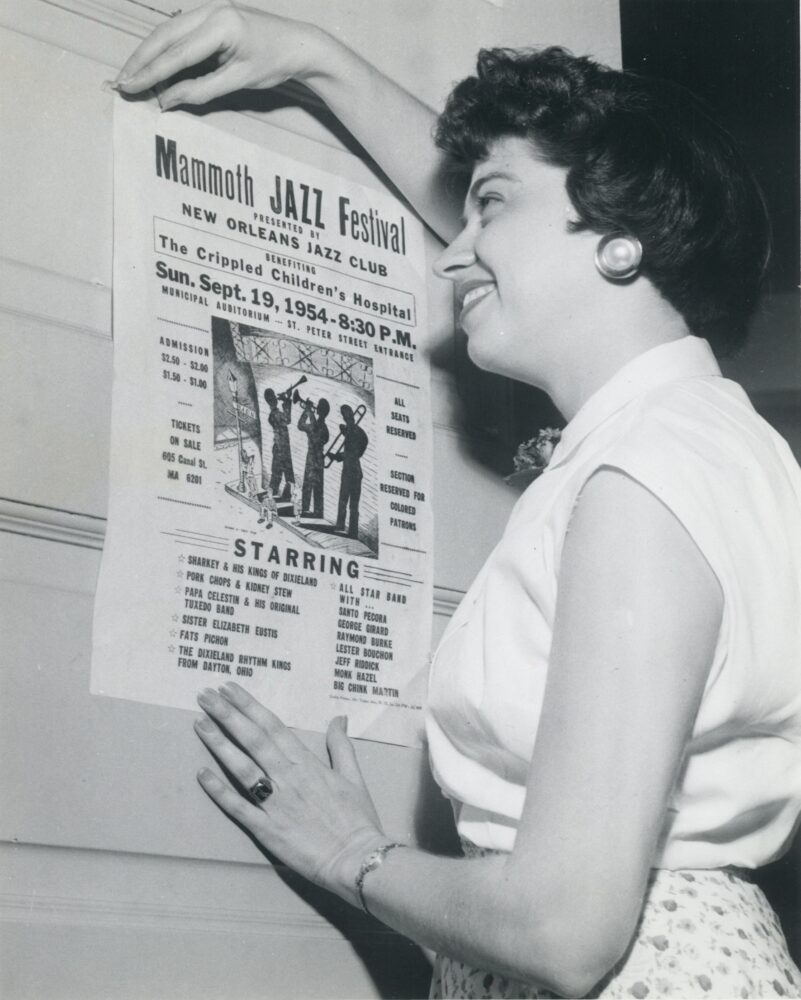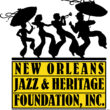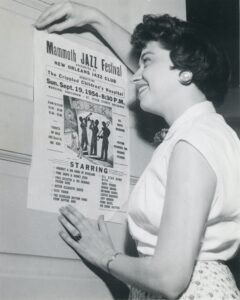Jazz Ladies
Women have been fundamental in building support for jazz and its history
Published: June 1, 2020
Last Updated: March 3, 2021

New Orleans Advocate / Times-Picayune and New Orleans Jazz Museum
Future president of the New Orleans Jazz Club Helen Arlt beams at a poster announcing a 1954 charity jazz festival.
“Women have participated in numerous ways, and in a variety of complex cultural contexts, throughout the history of jazz in New Orleans,” Tucker writes in her introduction. “While we do see traces of women’s participation in extant New Orleans jazz histories, we seldom see women presented as central to jazz culture. Therefore, they tend to appear to occupy minor or supporting roles, if they appear at all.”
Tucker’s research was conducted between 2001 and 2004. In 2017, in conjunction with exhibits on Storyville and women in jazz history at The Historic New Orleans Collection and the New Orleans Jazz Museum, the professor, who is based in Kansas, visited the city to give talks focused on her work. (Seemingly by luck, over at Tulane, the Hogan Jazz Archive’s then associate curator Alaina Hébert had also at that time used her institution’s holdings to curate an exhibit showcasing women’s roles in early jazz history, placing female performers alongside involved female friends and family members of male performers to draw a larger and more fully realized picture of the community that incubated and supported the music.)
As widely studied and carefully parsed as the evolution of jazz is, women have indeed rarely been positioned as significant to it, let alone “central.” As with, well, most history, the priorities of early preservationists and scholars compound into representation . . . or not. The 2017 events at Tulane and the Jazz Museum were a neat confluence of programming that revealed another, fresher angle—the role of women—to the heavily documented subject of New Orleans jazz. And in a bit of irony, that heavy documentation would not have been possible in the first place without the work of New Orleans women.
The New Orleans Jazz Museum has as its bedrock the collection of the New Orleans Jazz Club, a group of local enthusiasts who declared themselves on Mardi Gras Day 1948. Working at a time when many musicians and other involved parties who could remember the dawn of jazz were still living—more than a decade before the founding of Preservation Hall—the Jazz Club gang pooled resources to collect instruments, recordings, sheet music, and other ephemera that found their first display home in 1961 in a French Quarter cottage, and moved from venue to venue until finally being donated to the Louisiana State Museum in 1977. Beginning in 1950, the club also published the quarterly jazz-fan magazine the Second Line, which archives a growing collection of vintage issues online at nojazzclub.org.
From its earliest issues, the Second Line’s masthead reflects a gender-varied team, with female jazz aficionados like Helen Arlt, Myra Menville, and Frances Fernandez serving as editors of the magazine and in various roles on the club’s board, including as president, for decades. Journalist and historian Carolyn Kolb served as the museum’s last director before its collection moved into the Old US Mint building and became a branch of the Louisiana State Museum. Arlt was president of the club in 1965, when Louis Armstrong—who had boycotted his hometown for a decade leading up to the Civil Rights Act of 1964 because of segregationist restrictions on integrated bands—returned to New Orleans to play a benefit concert for the Jazz Museum. She and Menville served as official co-hosts for the visit. (Later, Frances Fernandez—who logged sixteen years as the club’s president—was instrumental in the efforts that got Armstrong on a postage stamp. Appropriately, she was also, in 1996, a member of the commission to establish the Jazz National Historical Park, which would sponsor Dr. Tucker’s research project fifteen years later.)
Popular music history is powered by the enthusiasm of fans—the collectors, promoters, radio hosts, curators, and writers who save, record, host, and remember. It’s behind-the-scenes work, for the most part, and as is the case with most things, women’s labor tends to lurk a little further behind the scenes than most.
In 1976, Menville and Arlt co-edited a special bicentennial edition of the Second Line, and noted in their editorial that the issue was dedicated to the photographers and writers who had, at that point, kept the publication going for close to thirty years by donating their talents. “These are the people we salute,” they wrote. “They are the recorders of jazz history. Jazz is American music. Its historians-custodians must be honored equally with its performers. Without them, there is no visible Past to guide the unauthored Future.” They could—maybe should—have been talking about themselves.
Alison Fensterstock’s writing has appeared in Rolling Stone, the New York Times, NPR, and various other places.

Sound Advice is funded in part by a grant from the New Orleans Jazz & Heritage Foundation.
